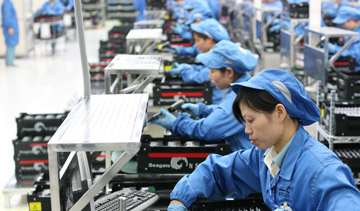It’s a rose that goes by many other names: backsourcing, onshoring – or a favourite of President Obama’s – insourcing. But whatever it winds up getting called, “reshoring” is a good thing for the North American manufacturing industry because it means work is coming home.
Unemployment numbers have been hovering between seven and nine percent since the recession started in 2008. Ontario’s unemployed rate (wher a large portion of Canada’s manufacturing operates) was at 8.0 per cent this past month, just higher than the national average of 7.3 per cent. So the return of work would certainly be cause for relief.
In fact, albeit a small boost, manufacturing employment did rise 1.4 percent in the past year, showing that a return to normalcy could be on the way.

Reshoring Initiative founder Harry Moser
Speaking at a press conference at IMTS (International Manufacturing and Technology Show) in Chicago was Harry Moser, the president (and founder) of the Reshoring Initiative – a group that aims to bring manufacturing jobs back to the US and North America.
The problem:
The crux of the talk focused on how manufacturers were improperly managing their supply chain – which is the reason jobs went offshore in the first place.
Moser stressed that while prices may be cheaper in China – in fact, case studies showed US prices were typically 189 per cent of Chinese prices – the total cost of ownership (TCO) was higher.
“They ignored about 20 percent of the manufacturing cost,” Moser said, referring to hidden costs that are factored into TCO. These costs include things like overhead and supply chain issues that occur when goods travel by ocean freight, which are sometimes difficult to calculate.
based on conservative estimates, he contends that 25 per cent of work would return if companies were basing decisions on TCO. However, Moser was also quick to point out that some other problems actually extended beyond the economic spectrum.
“Part of it’s the pure economics, but I think there’s a pain factor. (Manufacturers) got tired of getting up in the middle of the night and calling Asia. They got tired of quality problems, tired of delivery problems, tired of intellectual property litigations.”
The solution:
The solution, to Moser, is quite simple – operate locally. However, while Moser’s primary concern is the American industry, this philosophy is not necessarily centred on America.
“Whether it’s Brazil for South America, or China for Asia. We don’t say everything should be made here, but that each region should be largely self-sufficient.”
Moser believes that bringing work home or even having it “nearshored” will be a positive, because any work is good work.
“Say you set-up a stamping facility in Mexico, probably the dies will come out of the United States, wheras if the stamping is done in China, the dies will almost certainly come out of China,” he said.
The outlook:

Chinese net labour costs could converge with North Americas by 2015
Moser cited a report by Boston Consulting Group that suggested the net labour cost for manufacturing in China would converge with that of North America by the year 2015.
Of course, if this were to happen Chinese goods would start to lose that low-cost advantage that’s made them so widely consumed.
So if the forecasts are right and Chinese costs continue their ascent, Moser predicts we are likely to see approximately 1,000,000 jobs return to the US.
But what does this reshoring mean for Canada?
Moser’s outlook primarily concerned American manufacturers, but Canadian companies would naturally hope to count themselves among the benefactors of an American manufacturing resurgence.
He guessed that Canada could capitalize on anywher from 7 to 10 percent of the work available from nearshoring, but suggested the high dollar would be a problem.
“I think you obviously have somewhat of a problem with the currency being relatively high with commodities,” Moser said. “Realistically, (the US) do the nearshoring and it tends to be Mexico instead of Canada.”
While a high dollar may prove to be a deterrent to Canadian companies securing much of the work, at least the opportunity to get that work is coming back.




